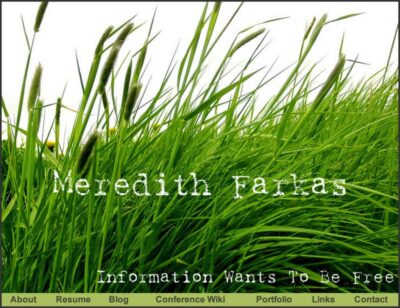Update: Peter offers an account of his presentation and his slides on his blog.
Ok, can I just say how much I love any conference with free wireless and outlets close to where I’m sitting?
Reading the Next Book
Peter is talking about what is means to interact with books in an online digital format, both in terms of the technologies and the privacy implications.
Peter quotes a 1920s literary historian, Richards: “A book is a machine to think with.”
Books are going digital through two different paths: digital production and retrospective scanning of analog works.
Publishers are increasingly moving into an all online production workflow. This has many advantages (cost savings), but it’s complex to implement. It’s a slow transition towards this model.
Scanning of materials takes place either externally (Google, MS, Ingram) or internally in an institution. Internal digitization = more control. External digitization usually has better content discover-ability.
Access modes: Old format are legacy ebooks with awful DRM that you download in a blob as a binary object. New is network-based access, reflowable text/html. Advantages are greater for text/html ePubs.
Advantages of text
- Native media easier to maintain than binary
- User enrichment is straightforward
- content can be redrawn by the user (to meet their unique needs)
- Easy accessibility
- Device independent
- Text is less demanding of handware
Advantages of network access
- Print on demand
- social – sharing, recommending, rating
- content enhancement (georef, temporal)
- licensing revenue is more attractive than purchase
- granular usage data
- Local caching with sync
- Constant content updates through push
- Greater account storage available
Google presents page images. Text-copy support is limited. Gogle does not support .epub, but they could.
How do we pay for this stuff? Public domain is free and it should be made available for free. Peter is very “militant” about the idea that people shouldn’t charge for access to public domain works. Heck yeah!
Revenue models – advertising supported or pay-per-view/licensing.
What can’t easily generate revenue is the class of “orphan works”: not obviously in public domain, probably out of print, could be in-copyright, but rights holder is uncertain.
If Google settled with publishers for in-copyright, out of print books… expect a licensing scheme with revenue sharing between publishers and Google. That’s library books digitized by Google and then resold by Google and licensed by libraries. Hmmm…
All online models are a mixed blessing.
Privacy implications: in a digital world, privacy doesn’t exist. It has to be engineered in. Because it’s expensive, user control of information may be the rarest artifact in the network. If we’re not careful, privacy will become commoditized, negotiable for purchase. Libraries protect the privacy of their readers in their contracts, but there are so many other places where latent data is collected about our users. One interesting example is Google StreetView. It’s incredibly useful, but is it a privacy violation?
Canada has a privacy officer that determined that StreetView was a violation of Canadian law. Google would need to make sure that people and license plate numbers are not identifiable.
The majority of network data collection is invisible to the user. Mobile phones know where I am, who I talk to, when I talk to them, who my friends are (it is amazing how comfortable so many of us are with that). Applications are coming out to take advantage of that data. Accepting some loss of privacy yields an enhanced product offering (recommendations, knowing if your friends are near you, etc.) with an opt-out/in option.
Privacy is not dissimilar from copyright. Google digitizes copyrighted material and provides an innovative and useful service with an opt-out option.
When we think of information flow online… Do we understand the data the government/corporations has access to online? How much control do we have to our identity, privacy and rights? We’re creating all this great stuff, but we need to constantly be aware of the privacy implications of what we are using (and having our patrons use). We have to decide together how these issues of privacy and network access work. We will shape reading by how we negotiate these issues.
As an aside, I often wonder how ideas about privacy will change as the folks now in their teens come of age. They have such different expectations (or perhaps a lack of awareness) of privacy and I question whether they will fight as vigorously for their rights to privacy given that they have grown up with these applications that use their data and don’t know another way of being. People in my generation have seen the shift towards these applications and devices, but they haven’t really, and in the U.S., where the government is not so great about protecting our privacy, I wonder what things will look like 20 years from now when the Gen Y folks are “in power” and they are the ones who need to protect privacy rights. Who knows?




Meredith,
As a member of the forty-something generation, I, too, worry about the lack of concern for personal privacy that younger generations may bring to bear. As a society infatuated with the latest gadget, we are used to asking “how does it work?”, but not “why must it be that way?” I strongly agree with you that if we are not careful, our privacy will become something we have to pay for, rather than a civil right. Keep speaking out on these important issues! With the popularity of your blog, your voice is heard by many, and can be used to shine the light of day on issues that some would prefer be kept hidden.
TV